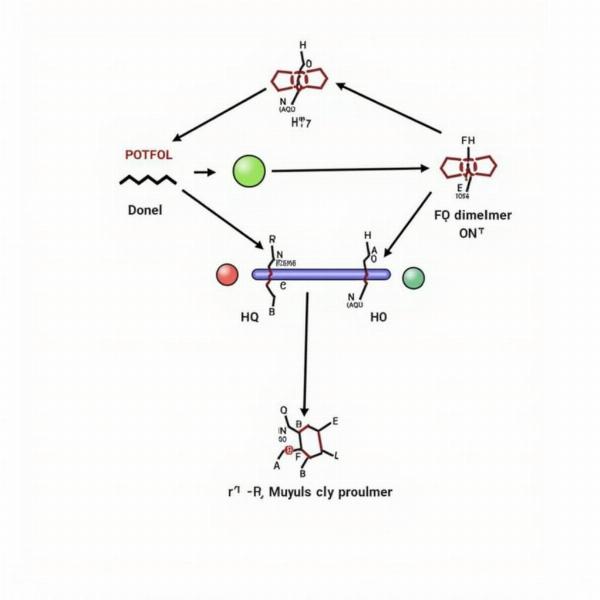Dimerise, a term often encountered in chemistry and biology, refers to the process where two identical molecules (monomers) combine to form a larger molecule called a dimer. Understanding the “dimerise meaning in Hindi” is crucial for anyone studying these fields in an Indian context. This article will delve deep into the various aspects of dimerisation, its significance, and its Hindi translations, providing a comprehensive understanding for both students and professionals.
Understanding Dimerisation: The Basics
Dimerisation is a fundamental process in many biological and chemical systems. It can occur through various mechanisms, including covalent bonding, hydrogen bonding, and hydrophobic interactions. The resulting dimer often possesses different properties than the original monomers. Think of it like two individual LEGO bricks joining together to create a new, larger structure with different functionalities. This simple analogy highlights the transformative nature of dimerisation.
Dimerise Meaning in Hindi: विभिन्न अनुवाद और उनका संदर्भ
The most common Hindi translation for “dimerise” is द्विलकीकरण (dvilkikaran). This term effectively captures the essence of two units combining. However, depending on the specific context, other translations might be more appropriate. For instance, in the context of protein chemistry, युग्मन (yugman), meaning pairing or coupling, might be a more accurate rendition. Similarly, संयोजन (sanyojan), which translates to combination or union, can also be used in certain situations.
Significance of Dimerisation in Various Fields
Dimerisation plays a crucial role in various fields, from chemistry to biology and materials science. In biology, protein dimerisation is essential for various cellular processes, including signal transduction and enzyme regulation. In chemistry, dimerisation is often used in the synthesis of polymers and other complex molecules. Understanding the “dimerise meaning in Hindi” is therefore essential for Indian scientists and researchers working in these diverse domains.
Dimerisation in Protein Chemistry
Protein dimerisation is a common phenomenon where two protein monomers bind together to form a functional dimer. This interaction can be crucial for the protein’s activity, stability, and regulation. Many important proteins, such as antibodies and receptors, exist as dimers.
 Protein Dimerisation Example
Protein Dimerisation Example
What are the different types of dimers?
Different types of dimers exist depending on the type of monomers and the bonds involved. These include homodimers (formed from identical monomers) and heterodimers (formed from different monomers). The bonds forming the dimer can be covalent, ionic, or hydrogen bonds.
How is dimerisation different from polymerisation?
While both involve the combination of monomers, dimerisation specifically refers to the formation of a dimer (two monomers). Polymerisation, on the other hand, involves the formation of a long chain molecule (polymer) from many monomers.
What factors influence dimerisation?
Several factors can influence dimerisation, including temperature, pH, concentration of monomers, and the presence of other molecules.
Conclusion: Mastering “Dimerise Meaning in Hindi”
Understanding the “dimerise meaning in Hindi” is paramount for navigating scientific literature and discussions in various fields. This article provided a comprehensive overview of the term, its different translations, and its significance across various scientific disciplines. By grasping these concepts, readers can enhance their understanding of complex biological and chemical processes and contribute meaningfully to the scientific discourse in India.
FAQs
-
What is the most common Hindi translation for “dimerise”?
The most common translation is द्विलकीकरण (dvilkikaran). -
Why is understanding “dimerise” important?
It’s crucial for understanding various biological and chemical processes. -
What is the difference between a homodimer and a heterodimer?
Homodimers are formed from identical monomers, while heterodimers are formed from different monomers. -
What is the significance of protein dimerisation?
It is crucial for protein activity, stability, and regulation. -
What factors influence the dimerisation process?
Factors include temperature, pH, concentration, and the presence of other molecules. -
Where can I find more information on dimerisation in Hindi?
You can explore scientific literature and online resources in Hindi. -
Can Meaning-Hindi.in help with translating scientific documents related to dimerisation?
Yes, absolutely!
Related Articles (If available, add links here)
Meaning-Hindi.in is your one-stop solution for all your Hindi translation needs. We offer a wide range of translation services, including business and commercial document translation, certified and legal document translation, technical and user manual translation, website and localization translation, educational and academic document translation, express translation, and specialized translation services. Whether you need to translate scientific research papers, technical manuals, or marketing materials, our team of expert translators ensures accurate and culturally sensitive translations. For top-notch Hindi translation services, contact us today at [email protected] or call us at +91 11-4502-7584. Meaning-Hindi.in is committed to providing high-quality, reliable, and affordable translation services to bridge the language gap and facilitate effective communication.